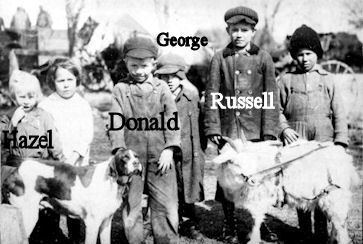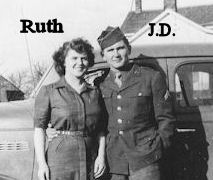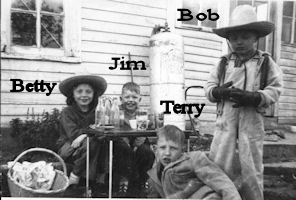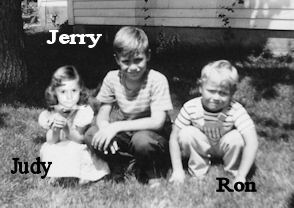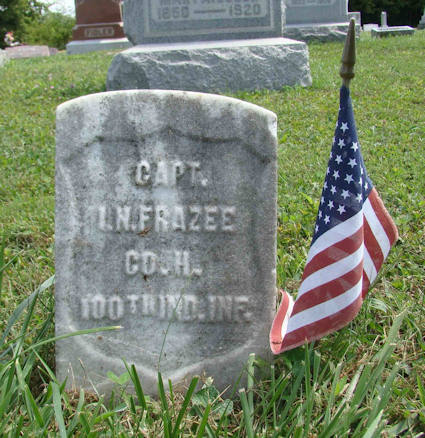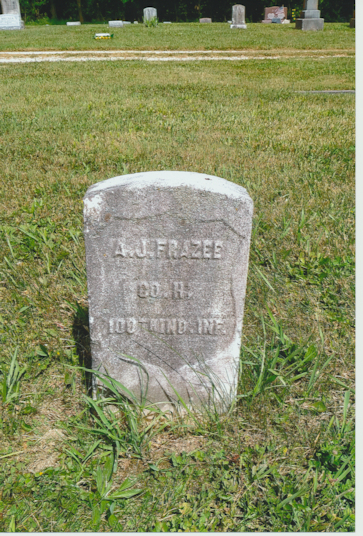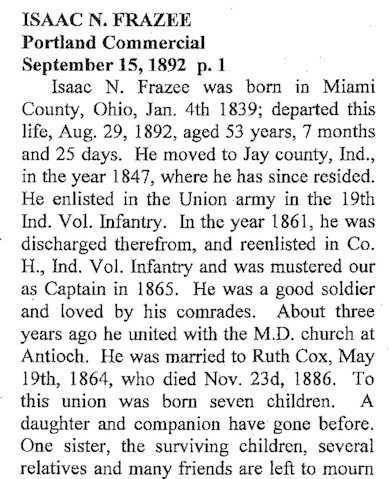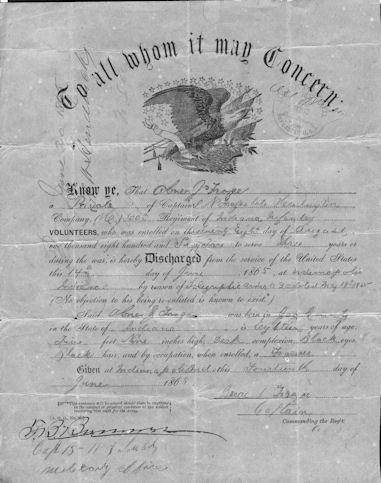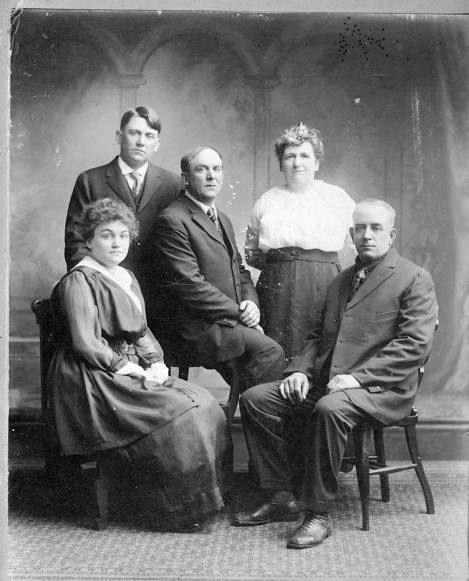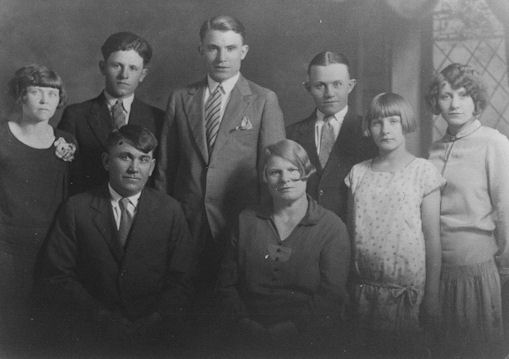History of Frazee Family in the Civil War
My Great Grandfather, Captain Isaac Newton Frazee

|
.Ancestry of the
Frazee Family It had been known in the Frazee family
that we had a relative who served in the Civil War. Not much was
known about who he was and just exactly what he did in the Union Army.
Several years ago I was at the Vicksburg Battlefield and learned that
the National Park Service has a list of everyone who served in the
Civil War, Union or Confederae. On a chance that I might learn some-
thing about this relative I looked him up. I also looked up the name
of my Great Grandfather who was about the same age. I learned that the
mystery service member and my Great Grandfather were brothers and
they both served in the 100th Indiana Infantry. By using the internet
I have been able to learn a lot more about the Frazee brothers who
fought with the Union Army and this is what I learned.
Created by Bob Frazee Copyright 2018, all rights reserved. Updated: 5 Feb 2013; 2 Feb 2014, 7 April 2017, 23 May 2017, 24 March 2018 |
The Frazee Clan
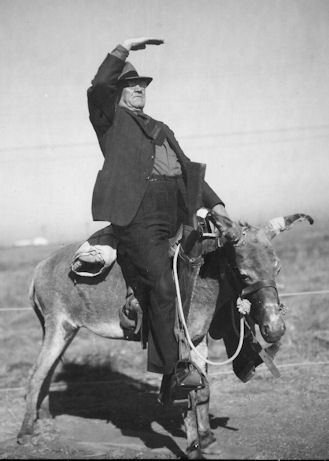
Oliver Sidney Frazee
|
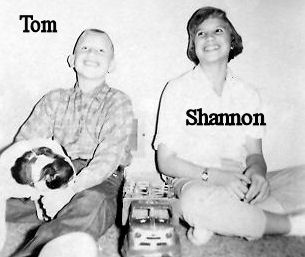

|
I am constantly adding new informaton to this page so
you may find some repetition and information not in the best
sequence but this is a work in progress and
Under Construction so come back often.
28 March 2018
Isaac Newton Frazee, and his younger brother, Abner J. Frazee, both living in Indiana, served in the Civil War. Isaac, the older of the two, enlisted in the 19th Indiana Infantry Regiment (Volunteers) in July, 1861, and was promoted to Corporal before his discharge (date and reason unknown).
On August 28, 1862, Isaac Newton Frazee next enlisted in Company H, 100th Regiment Indiana Infantry (Volunteers). His younger brother Abner J. Frazee enlisted at the same time. Isaac enlisted as a 1st Sargeant (probably because of "prior service" which means he was not a raw recruit) and Abner was a Private. The Regiment fought with General Grant at the siege of Vicksburg, Mississippi, participated in the Battle of Chatanooga at Lookout Mountain and Missionary Ridge and then marched to Atlanta and Savanah with General William Tacumseh Sherman. At the end of the war Abner was still a Private and Isaac had been promoted to Captain of Company H, 100th Regiment Indiana Infantry. In doing my research at the various National Civil War Parks I found it was hard to find references to the 100th Infantry Regiment. I learned after my trip that the Union Regiments were attached to larger units (ie. The 100th Infantry Regiment was initially attached to the 2nd Brigade, District of Memphis, Tenn., 13th Army Corps (Old), Dept. of the Tennessee) Since units were frequent reassigned to new Divisions and Army Corps it is necessary to start searching at the Division or Corps level.
I have contacted the State of Indiana and obtained a copy of the history and rosters of the 19th Indiana Infantry Regiment (Volunteeers) and the 100th Infantry Regiment (Volunteers) as well as enlistment, discharge, and burial records of Issac Newton Frazee and Abner J. Frazee.
I thought it might be of interest to know how the military organization is structured. It comes second nature to me because of my military expereince in the 4th Armored Division in Germany and having attended the Command and General Staff Collage. But it may not be so clear to other. So if you have an interest:
The infantry in the Civil war and up to the end of the Cold war had the following command hierarchy from top to bottom:
Army - there can be more than one Army depending upon geographical ares of the theater of operations is. An Army will have command and control over one or more Corps.Corps - A Corps will have command and control over several Divisions, again depending on size of theater of operations.
Division - A Division will have command and control over several Brigades.
Brigade - A Brigade will command several Regiments/Battalions.
Regiment/Battaliion - A Regiment will command several Companies
Company - A Company is made up of several platoons which it controls
The object of this organization is to have versatility and a known command structure. So units cn be shifted around as needed and everyone knows where he fits in the structure and who his immediate commender is. Thus intially the 100th Indiana Infantry Regiment was assigned to the 1st Brigade, 1st Division, District of Memphis (the Army), 13th Army Corps
Units the 100th Infantry Regiment (Volunteers) was attached to
and list of major battles.:
15th Army Corps Commanded by MG William Tecumseh Sherman.
(Battle of Missionary Ridge, Chatanooga, Tennessee: November, 1863;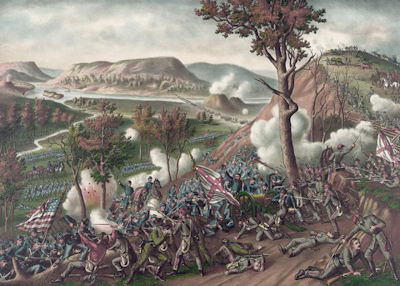
Battle of Missionary Ridge, 1863
and list of major battles.:
Organized at Fort Wayne, Ind., and mustered in on September 10, 1862.
Left State for Memphis, Tenn., 11 November 11.
2nd Brigade, District of Memphis, Tenn., 13th Army Corps (Old), Dept. of the Tennessee, November, 1862.1st Brigade, 1st Division, District of Memphis, 13th Army Corps, November to December, 1862.
1st Brigade, 1st Division, 17th Army Corps, December, 1862, to January, 1863.
1st Brigade, 1st Division, 16th Army Corps, January to July, 1863.
(Siege of Vicksburg, Mississippi: May - July, 1863;
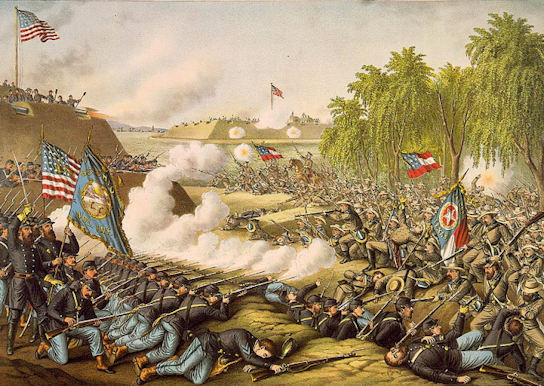
Siege of Vicksburg; Confederates surrendered July 4, 1863 (the same day as the Battle of Gettysberg took place)
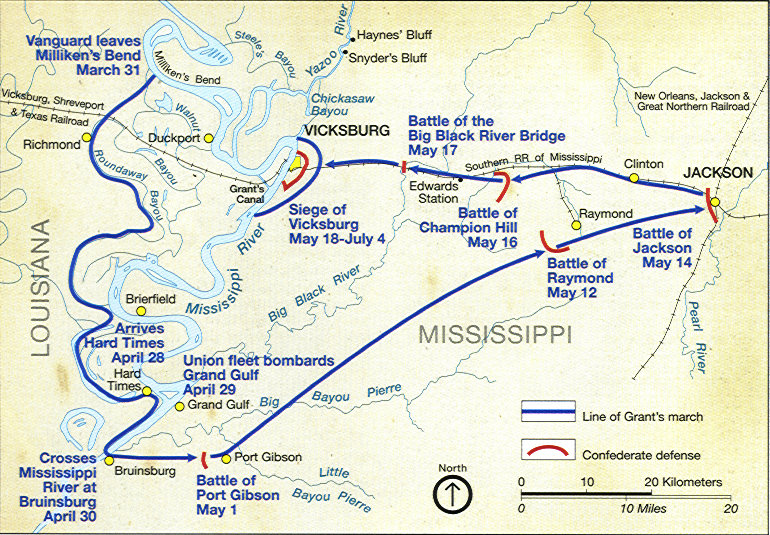
Map of the Siege of Vicksburg - 1963
15th Army Corps Commanded by MG William Tecumseh Sherman.
(Battle of Missionary Ridge, Chatanooga, Tennessee: November, 1863;

Battle of Missionary Ridge, 1863
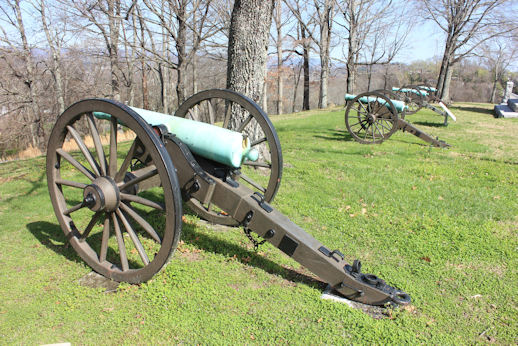
Missionary Ridge, March, 2018
Battle of Knoxville, Tennessee: November, 1863;
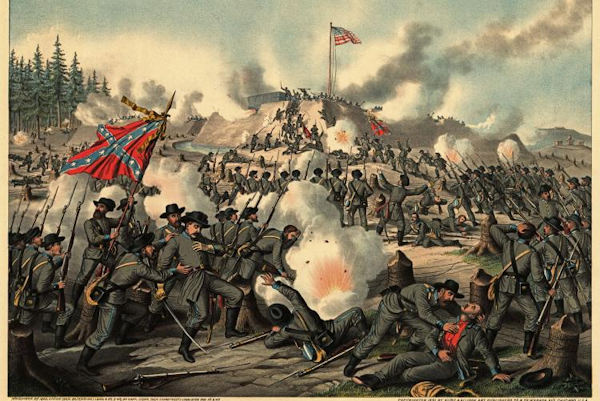
Rescue of Knoxville - November, 1963
Battle of Atlanta, Georgia, May 1864)
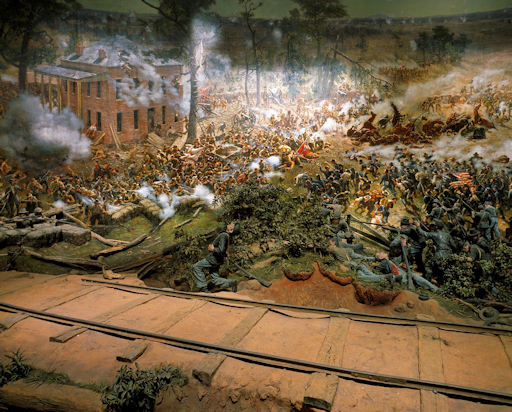
Battle for Atlanta - May 1864
2nd Brigade, 1st Division, 15th Army Corps, September, 1864 to June, 1865.
Savannah, Georgia, December, 1864)
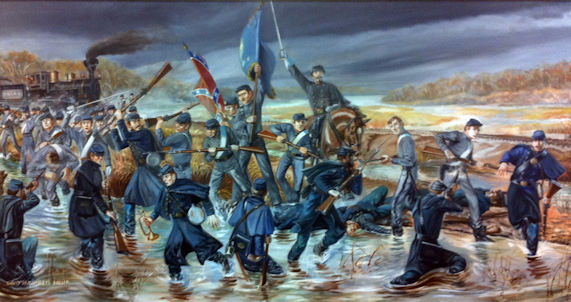
The Battle for Savannah - Decemberf 1964
In the Civil War the Union army was made up of Regiments of Volunteers organized within the individual States. Similar to the National Guard today. The United States had no standing army to speak of. Raising an army was left to the states. The states formed the units and picked the uniforms -- this is why you see pictures of Civil War uniforms of all colors and design at the start of the war. The units formed by the states were designated "Volunteers". A unit formed by the federal government were disignated "Regular". When officers where commissioned they might have a rank of "Volunteer" or "Regular". Getting a regular army commission was important. General Grant and General Sherman were both Volunteers but later commissioned as Regular Army.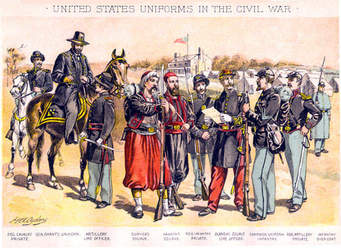


When the units were adequately trained it could be integated into the Union army. This gives some insight to the 2nd Amendment which prohibits the federal government from infringing on the right to bear arms -- it was essential for the states to be able to form a malitia which could be incorporated into a federal armed force. Men enlisted into companies based upon the county they lived in. Both 1st Sgt Isaac Newton Frazee and Pvt Abner Frazee enlisted in Company "H", of the 100th Regiment Indiana Infantry, Jay County on August 28, 1862, for three years of service. See page 558, Company H, Roster of 100th Regiment, Indiana Infantry. This Regimental History shows the Company was present at the Battle of Vicksburg, Mississippi, and the Battle of Chatanooga, TN, at Lookout Mountain and Missionary Ridge, The relif of Knoxville, the Battle for Atlanta, Georgia, and marched to the sea with General William Tecumseh Sherman. They were mustered out on June 8, 1865, in Washington, D.C.
Imagine this if you will: Most people in the 19th Century lived, and died, within 50 miles of where they were born. They never saw any more of the country than that. These soldiers of the 100th Indiana Infantry Regiment marched and fought their way from Indiana to Tennessee, Alabama, Mississippi, Georgia, North and South Carolina, Virginia and then to the nation's capital, Washington, D.C., before returnng to their beloved homes in Indiana. It staggers the imagination.
Forming army units during the Civil War was unique and left to the individual states. The number of the Regiment would tell you something about how early in the war it had been formed. Thus the 19th Indiana Infantry Regiment (Volunteers) would have been formed much earlier than the 100th Indiana Infantry Regiment (Volunteers). There was a very small federal army and the Volunteer units would be incorporated into larger military unites which were commanded by Federal Officers. Sometimes someone would try to organize a Regiment but not enough Companies could be filled so that Company would be incorporated into an existing Regiment. If the casualties of a Regement where high it might be incorporated into another Regiment. (i.e. The 19th Infantry was incorporated into the 20th Infantry)
There are a number of factors which played an important role in the conduct of the Civil War.
The first to be considered were the river systems running through the heartland of the United States. The Mississippi River cut the country in half and thus control of the Mississippi was essentual to cutting the Confederacy in half. Thus control of Memphis, Tennessee, New Orleans, Louisiana, and Vicksburg, Mississippi, were so important. Vicksburg was the hardest to capture because of geography -- high banks overlooking the river to the west and fortifications to the east. The most important tributaries of the of the Mississippi were the Ohio, Cumberland and Tennessee rivers because they allowed both the Confederate and Union armies to transport large numbers of soldiers and vast supplies long distances cheaply and fast. All these rivers flowed from the Appalachian Mountians west to the Mississippi. Steam steam boats which could travers both with and against the current were invaluable.
Here's an interesting historical perspective: Do you remember Samuel Clemons, "Mark Twain"? He grew up in Hannibal, Missiouri, a small river town on the banks of the Mississippi River north of Saint Louis. As a teenager he had the "wonder lust" and wanted to travel the Mississippi. Like a lot of young men in Hannibal he aspired to be a riverboat pilot. He started his apprenticeship in 1857 and in 1859, at the age of 23 he was awarded a license as a Mississippi Riverboat pilot. This career came to an abrupt end and he went on to other pursuits; do you know why? It was the Civil War. The Union navy shut down all river boat traffic on the Mississippi and Ohio Rivers. Only military naval traffic was allowed. Clemons' boat, and hundreds of others, were dry docked and anyone making a living on the river had to search for different professions. Believe it or not Samuel Clemons joined the Confederate army but after two days he decided this was not a life for him so he deserted. He traveled west to Virginia City, Nevada, where he got a newspaper job and his writing career was born.
The Second thing which was important to fighing the war were the railroad systems which had been developed. It allowed vast number of troops and supplies could be shipped inland long distances,fast and were not affected by bad weather. Military supplies (weapons, ammunition, medical equipment and rations -- the army lived on coffee and hardtack) which had to be shipped by horse drawn wagons were slow and could get bogged down in bad weather. Thus control of the railroad centers and lines were important. The Battle of Shiloh took place because Union troops were being sent to Corinth, Mississippi, an imporant railroad junction for the Confederacy which supplied the Mississippi River stronghold of Memphis, Tennessee. Union troops were sent deep into Tennessee on the Tennessee River and landed at Pittsburg Landing just a short distance from Corinth, Mississippi. The same is true for railroad centers at Chatanooga, Tennessee, Nashville, Tennessee, and Atlanta, Georgia. The goal of Sherman's march to Savannah, Georgia, was to capture the second largest seaport serving the Confederacy. It demonstrated to the population that the South was loosing the war and destroyed the morale of the South.
Third was the development of the telegraph. Armies live by command and control. Knowing where the enemy is located and being able to move your forces to the right place is imporant. Thus, in a matter of minutes General Grant was able to control the movement of his forces which were spread over thousands of miles throughout the Confederacy. If a Confederate unit was discovered in a certain place General Grant or General Sherman were able to move their forces accordingly. Likewise, if a unit was in trouble reinforcements could be sent quickly and abort a defeat. Prior to the telegraph messages were sent by "runners" on foot or "couriers" on horseback. If you apply this concept to today's modern army you can understand the advantage to a unit which has access to air craft and satillite survallance.
What got me started on creating these notes about the Frazee brothers in the Civil War was reading the Personal Memoirs of Ulysses S. Grant which I purchased for $0.99 on Kendle. General Grant describes in detail his boyhood, attendance at West Point, and his his military career. It is fascinating how Genereal Grant's experiences at West Point and then the war against Mexico influenced his stratigies in the Civil War. Many of his classmates and commrades in the Mexican war became Southern Generals. He knew how they would respond in battle -- which ones would run, which ones would bluff and then retreat and which ones would stand and fight.
It is often not understood that the Confederate Army was never a cohesive unit with one General which had command control of all the Confederate Armys. There was no central command structure like General Grant was "General in Chief". Each Confederate state had its own army which for the most part operated independently from the other armys. At the start of the war each Confederate state formed its own army and the senior officer was suppose to be a Brigadier General (one star). It appears there was only a loose co-ordination through Jefferson Davis, President of the Confederacy. But Virginia inticed Robert E. Lee to be it's army's Commanding General and they made him a Major General (two stars). This caused some consternation among the other Brigidier Generals of other states because it meant he out ranked them but he had no official command over the other Confederate forces. The Army of Northern Virginia, led by General Robert E. Lee, was the target of the Union forces, the Army of the Potomic, because of the threat it posed to Washington, D.C. When General Lee surrendered his Army of Northern Virginia that did not end the war but Lee knew the other General's would see the futility of continuing and would surrender in time. At Appommattox General Grant asked General Lee to order the Commanders of the remaining active Confederate armys to surrender to the union forces. General Lee responded that he only commanded the Army of Northern Virgina and because these other units were not under his command he had no authority to issue such an order. As a result it was several months, and battlefield deaths, later but eventually all the Generals surrendered their armies and the Civil War was officially over -- but President Lincoln did not live to see it.
I have recently read three very interesting, books on the Civil War:
Two of the books are about the Union Army. American Ulysses: A Life of Ulysses S. Grant, by Ronald C. White, 2017, and William Tecumseh Sherman: In the Service of My Country, A Life, 2017, by James Lee McDonough. These biographies describe the Civil War as seen by these two Generals. You will get an opportunity to see an overall view of the war as experienced by each of these senior commanders in two separate theaters of the War. You will get a better idea of the battles where Indiana's Company H, 100th Infantry Regiment was engaged. General Sherman was a real military scholar and philosopher. He understood better than most about the causes and the eventual outcome of the Civil War. He knew that the Confederacy had no idea what a war would bring to the South. He also understood the Union would prevail because it was a manufacturing giant and had a greater population base to draw new recruits. Both General Grant and General Sherman understood the Union would just "over power" the Confederacy. I recommend you consider reading these books.
The third book, Clouds of Glory: The Life and Legend of Robert E. Lee by Michael Korda, 2014, is a very interesting biography of General Lee which give a perspective of the war from the Confederate's view. Naturally its focus is on the Army of Northern Virginia which General Lee commanded. A West Point Graduate, who made his reputation while serving in the Mexican war, Captain Lee was the darling of General Winfield Scott, the General-in-Chief of the United States Army. Although he had limited command experience President Lincoln offered Colonel Robert E. Lee the command of the Army of the Potomac. Lee turned it down because he could not fight against his native state -- this gives you an insight on how many people in the south considered themselves citizens of a state and not of the United States. Col Lee resigned his U.S. Army commission to take command of the Army of Northern Virginia. The Confederacy never had a chance to win the Civil War and the personalities and conflicts between the various Confederate Generals only exacerbated the problem.
Russell L. Frazee's Comments about the Civil War. In the mid 1950's my father, Russell L. Frazee, Grandson of Isaac Newton Frazee, became interested in the Civil War but his research tools were limited (no internet back then) and it may have been sparked when he read several books by Bruce Catton, include Glory Road, This Hallowed Ground, and A Stillness at Appomattox, which he recommended reading. His comments about the war were more generic about the civil war but nothing specific about his Grandfather's role in it: "Anyone interested in Civil War drama and the feelings and passions of the battlefield may find these works worth reading. The following information was gleaned from Bruce Catton's Mr. Lincoln's Army edited in 1954 and in whose book the famous Black Hat Brigade and its exploits are frequently referred to. This latter book is an interesting historical work about the Civil War as view through the Army of the Potomac, with all of its failures, misfortunes, and lack of leadership on the top level. The 19th Indiana Volunteer Infantry was the pet regiment of Gov. Oliver P. Morton of Indiana. A sketch of the regiment's career is printed in "Indiana at Antietam," pp 107-123. The 19th Indiana, with the 2nd, 6th, and 7th Wisconsin Regiments, was assembled in Fredericksburg in the spring of 1862 and placed under the command of young John Gibbons. This outfit, the 19th Indiana, 2nd, 6th and 7th Wisconsin Regiments became known as the "Black Hat Brigade," which was to become famous throughout the remainder of the Civil War. The men of this outfit were outfitted, beyond regulations, with black felt hats and white gaiters/ hence their nickname, "The Black Hat Brigade." It served with valor in the army of the Potomac under McClellan, Hooker, and Meade, the army often referred to in Civil War history as "Mr. Lincoln 's Army." The Black Hat Brigade fought with distinction in the battles of Gainesville, Warrentown, South Mountain, Antietam, Second Battle of Bull Run, and the Battle of Gettysburg. It was at the battle of South Mountain that the Black Hat Brigade became known as the "Iron Brigade." The accepted story is that McClellan, watching its progress up the gap of South Mountain, had exclaimed in admiration: "That brigade must be made of iron!" Whatever its origin, the name stuck, and the brigade lived up to it valiantly the next summer at Gettysburg. See Gibbons Personal Recollections. 20th Indiana Volunteer Infantry." [Catton's book Stillness at Appomattix mentions the Iron Brigade in the Battle of Spottsylvania and Cold Harbor.] Web Master's Note: (Robert Frazee, son of Russell L. Frazee and Great Grandson of Isaac Newton Frazee, Captain, Company H, 100 Regiment Indiana Infantry) It is interesting to note that my father appears to have known nothing about Isaac's discharge from the 19th Indiana Infantry Regiment and subsequent enlistment in the 100th Regiment Indiana Infantry. Oliver Frazee, Russell's father and my grandfather, the son of Isaac Newton Frazee, was about 38 years old when his father died and may not have discussed much about Isaac's experieneces in the Civil War. Some of those battles were so horrific and Isaac may not have talked about it, as is common of many returning soldiers. Isaac died before Russell was born and therefore Russell did not know his grandfather. All of the above history of Isaac's Civil War experience has been developed by me following a visit to the battlefield in Vicksburg, Mississippi about 2015. There is a Monument to the Indiana units which served at Vicksburg but I had no knowledge that my Great Grandfather served in one of the units. I should go back and get a picture. |
Isaac Newton Frazee was married twice. His first marriage was to Adelia Coldren who was a sister of Charles Coldren's father (Hosea Coldren who had married Mary Frazee, a daughter of David (2) Frazee by his first marriage.) Of this first marriage to Adelia Coldren, one child, a daughter was born about 1851, named Clara (4) Frazee.
Isaac Newton Frazee (3) second marriage was to Ruth Ann Cox. Ruth Ann Cox was born August 11, 1846. She died November 23, 1886, at the age of 40 years. Isaac died August 29, 1892, and was buried at Antioch Cemetary, Jay County.
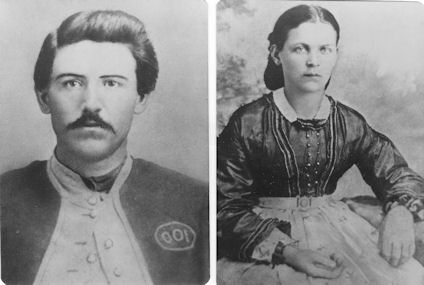
Isaac Newton and Ruth Ann Frazee nee Cox
(Photo provided to family members by Wilma Frazee nee Hyndman)
-->
Go to Isaac Newton Frazee in the 19th Indiana Infantry


This page was created by Bob Frazee, Colonel, U.S. Army (Ret.)
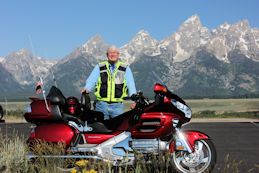
Belli at the Grand Titons, June 2015
If you have any questions, or corrections, just write to Belli.
Have a good day and come back again.

